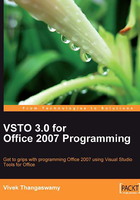
Microsoft Office InfoPath
When you design an InfoPath form, InfoPath creates a .xsn file, which is stored internally as a cabinet ( .cab) file because it can actually contain additional subfiles. In other words, the .xsn file contains all of the necessary subfiles required to assist users in entering data and validating it.
There are two ways to see the files that are contained inside a .xsn file. The first approach is to open your .xsn InfoPath form in InfoPath designer. InfoPath designer is simply the Microsoft Office InfoPath 2007 form template design environment. The second approach requires a little more effort. You can rename your .xsn files to the .cab extension and then extract all of the files related to the original .xsn file to a specified folder. Microsoft Office InfoPath 2007 is based on an industry-standard Extensible Markup Language. This allows developers to create customized tags that offer flexibility in organizing and presenting information.
At this point, you might ask: if InfoPath is built into Microsoft Office, why are we discussing it as a part of Visual Studio? Here's why. Even though the InfoPath designer has remarkable features for creating forms with validation rules, a lot of design capabilities cannot be achieved using the standard InfoPath environment. When you find that you can't create the forms that you want by using the InfoPath designer, you would typically resort to scripting, or managed code, to achieve the functionality that you wanted. With both InfoPath and Visual Studio, that's not necessary. A Visual Studio tool for Office development provides an environment that allows you to integrate Visual Studio with Microsoft Office's InfoPath tools, to create a virtually limitless approach to forms creation.